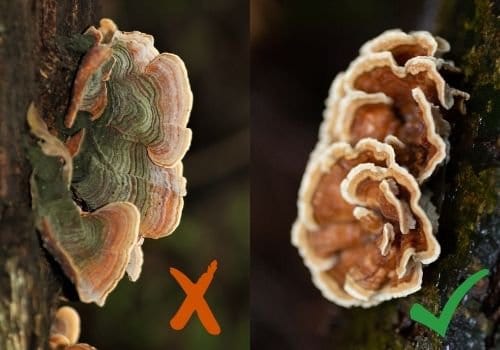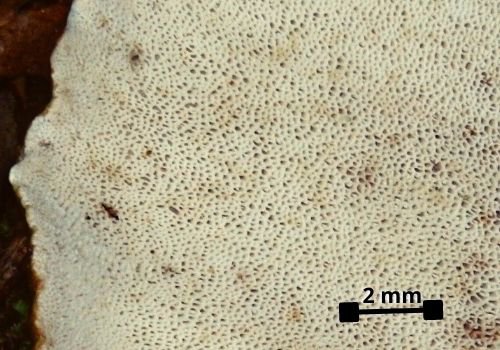Hey there, fellow fungi enthusiasts! Are you curious about the fascinating world of turkey tail mushrooms? Well, you’ve come to the right place! Today we’ll embark on a journey to uncover the secrets of identifying these remarkable mushrooms separating them from their lookalikes, and exploring their potential benefits.
The Turkey Tail Advantage: A Safe and Abundant Forage
One of the most exciting things about turkey tail mushrooms is that they don’t have any toxic lookalikes This means that even if you’re a beginner forager, you can confidently search for them without worrying about accidentally picking something harmful. Plus, they’re incredibly abundant in the wild, so you’re likely to find them growing on dead trees and logs in forests around the world
The 4-Point Checklist: Your Turkey Tail Identification Toolkit
Here’s a helpful 4-point checklist to help you tell the real deal from the fakes:
- Pore Power: Flip the mushroom over. If you see tiny pores on the white underside, you’ve found a true turkey tail. These pores are like tiny mouths that release spores for reproduction.
- Velvety Touch: Run your fingers over the top side of the mushroom. If it feels velvety and soft, it’s a good sign.
- Colorful Concentric Bands: Look for colorful rings of different shades on the top side. This is a characteristic feature of turkey tail mushrooms.
- Flexibility Test: Take the mushroom in your hand and gently bend it. If it’s thin and flexible, you’re in luck!
The Lookalike Lowdown: Don’t Be Fooled!
While turkey tail mushrooms are relatively easy to identify there are a few imposters out there that can trick even experienced foragers. Here are the most common lookalikes to watch out for:
- Stereum ostrea: This false turkey tail often has a smooth, yellow underside and may have algae growing on it.
- Stereum hirstum: Similar to S. ostrea, this lookalike also has a smooth underside and lacks the velvety texture of true turkey tail.
- Trichaptum abietinum: This imposter has teeth instead of pores on its underside, making it easy to distinguish from the real deal.
Turkey Tail Tea: A Delicious and Healthy Brew
There are several ways to enjoy turkey tail mushrooms once you can identify them with confidence. One popular option is to brew a delicious and healthy tea. To enjoy the earthy, healthful brew, simply mix 1-2 teaspoons of the mushroom powder with a cup of hot water.
Beyond the Basics: Dive Deeper into the World of Turkey Tail
If you’re eager to learn more about these fascinating mushrooms, here are some additional resources:
- Turkey Tail Mushroom Benefits & Science: A Complete Guide
- 17 Turkey Tail Mushroom Facts At A Glance
Shop Turkey Tail: Get Your Hands on This Superfood
When you’re prepared to personally discover the advantages of turkey tail mushrooms, visit our store to look through our selection of premium turkey tail products, which includes blends, powders, and capsules.
Let’s Get Foraging!
Now that you’re armed with the knowledge and tools to identify turkey tail mushrooms, it’s time to head out into the wild and start foraging! Remember to always be respectful of the environment and only harvest mushrooms that you’re 100% sure are safe.
Happy foraging!
Real Versus False Turkey Tail
Turkey tail mushrooms grows abundantly on dead trees and logs in the wild. They are one of the most common forest mushrooms. Turkey tail can come in a wide range of colors, and one can look quite different from another.
But it doesn’t end there. Some other mushrooms look very much like Trametes versicolor, making things more confusing. These imposters are commonly called “false turkey tail mushrooms,” and include Stereum ostrea, Stereum hirstum, and Trichaptum abietinum.

So, how can you tell the difference between “true” and “false” turkey tail mushrooms?
If you come across what looks like Trametes versicolor on your hike, flip the mushroom over. A true turkey tail fungus is classified as a polypore (i.e., one that has pores visible on its white underside). many pored) mushroom. Whereas, S. ostrea and S. hirstum have yellow, smooth undersides. You will also commonly find S. ostrea mushrooms with algae on them (1).
Turkey Tail Mushroom Identification Checklist
If you can answer “YES” to all of the following questions about the mushroom you’re looking at, you’ve found true turkey tail!
- If so, the image below shows what the pores on the underside of your mushroom should look like.
- Does the top side of the mushroom have little hairs that make it feel velvety?
- Does the mushroom have colored bands that are concentric on its upper side?
- Is the fresh mushroom flexible and thin, as demonstrated in the video below?

How to Identify Turkey Tail Mushrooms ( and distinguish from false lookalikes )
FAQ
How do you identify a turkey tail?
Are there any poisonous turkey tail look alikes?
Is it healthy to eat turkey tail?
What tree does turkey tail grow on?
What does a false turkey tail look like?
The False Turkey tail is not a polypore like the True Turkey tail so it does not have pores on the underside. It is a shelf like bracket looking mushroom similar to the True Turkey tail. This one is a crust fungus. When you fist see this mushroom you may think it looks like a paint stain on the mood when it is actually a mushroom.
What does a turkey tail mushroom look like?
This large pored mushroom is a turkey tail mushroom look alike. The pores are clearly visible, and it may be another Trametes species, but it’s not a true turkey tail (Trametes versicolor). These were found on a stump just a few feet from a big patch of true turkey tails. Is the mushroom surface fuzzy?
How do you know if a mushroom has a false turkey tail?
If it has no pores, it is likely a false turkey tail. Trametes Versicolor: Also known as the “rainbow fungus,” this mushroom looks similar to turkey tail and has a similar medicinal value. However, it has a thicker flesh and is less flexible than turkey tail. To differentiate between the two, try bending the mushroom.
What is a turkey tail?
Turkey tail’s scientific name, Trametes versiolor, translates to “one who is thin” and “of several colors.” It’s a perfect description that was originally assigned to the mushroom in 1939 by Czech mycologist Albert Pilát; before that, Swedish naturalist Carl Linnaeus had called it Boletus versicolor. [ 1]
